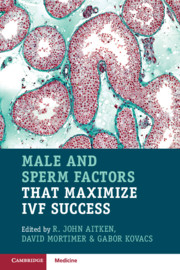Book contents
- Male and Sperm Factors that Maximize IVF Success
- Male and Sperm Factors that Maximize IVF Success
- Copyright page
- Contents
- Contributors
- Chapter 1 Sperm Selection for ART Success
- Chapter 2 New Horizons in Male Subfertility and Infertility
- Chapter 3 Chromosome Abnormalities and the Infertile Male
- Chapter 4 The Effect of Endocrine Disruptors and Environmental and Lifestyle Factors on the Sperm Epigenome
- Chapter 5 Lifestyle Factors and Sperm Quality
- Chapter 6 The Effect of Age on Male Fertility and the Health of Offspring
- Chapter 7 The Assessment and Role of Anti-sperm Antibodies
- Chapter 8 FSH Treatment in Male Infertility
- Chapter 9 Antioxidants to Improve Sperm Quality
- Chapter 10 The History of Utilization of IVF for Male Factor Subfertility
- Chapter 11 The Case Against Intracytoplasmic Sperm Injection for All
- Chapter 12 Perinatal Outcomes from IVF and ICSI
- Chapter 13 Artificial Insemination with Partner’s Sperm for Male Subfertility
- Chapter 14 Obstructive Azoospermia: Is There a Place for Microsurgical Testicular Sperm Extraction?
- Chapter 15 Should Varicocele Be Operated on Before IVF?
- Chapter 16 Donor Insemination: Past, Present and Future Perspectives
- Chapter 17 DNA Damage in Spermatozoa
- Chapter 18 Prevention of Male Infertility: From Childhood to Adulthood
- Index
- References
Chapter 13 - Artificial Insemination with Partner’s Sperm for Male Subfertility
Published online by Cambridge University Press: 24 May 2020
- Male and Sperm Factors that Maximize IVF Success
- Male and Sperm Factors that Maximize IVF Success
- Copyright page
- Contents
- Contributors
- Chapter 1 Sperm Selection for ART Success
- Chapter 2 New Horizons in Male Subfertility and Infertility
- Chapter 3 Chromosome Abnormalities and the Infertile Male
- Chapter 4 The Effect of Endocrine Disruptors and Environmental and Lifestyle Factors on the Sperm Epigenome
- Chapter 5 Lifestyle Factors and Sperm Quality
- Chapter 6 The Effect of Age on Male Fertility and the Health of Offspring
- Chapter 7 The Assessment and Role of Anti-sperm Antibodies
- Chapter 8 FSH Treatment in Male Infertility
- Chapter 9 Antioxidants to Improve Sperm Quality
- Chapter 10 The History of Utilization of IVF for Male Factor Subfertility
- Chapter 11 The Case Against Intracytoplasmic Sperm Injection for All
- Chapter 12 Perinatal Outcomes from IVF and ICSI
- Chapter 13 Artificial Insemination with Partner’s Sperm for Male Subfertility
- Chapter 14 Obstructive Azoospermia: Is There a Place for Microsurgical Testicular Sperm Extraction?
- Chapter 15 Should Varicocele Be Operated on Before IVF?
- Chapter 16 Donor Insemination: Past, Present and Future Perspectives
- Chapter 17 DNA Damage in Spermatozoa
- Chapter 18 Prevention of Male Infertility: From Childhood to Adulthood
- Index
- References
Summary
According to a number of high-quality studies, intrauterine insemination (IUI) with homologous semen should be the first choice of treatment in the case of moderate male factor subfertility. IVF and ICSI are clearly over-used in this selected group of infertile couples. The limited value of IUI in infertility treatment, as mentioned in the 2013 NICE guidelines, was surely a premature statement and should be adapted to the actual literature. Oxidative stress and high sperm DNA damage is associated with lower pregnancy rates after IUI. Concerning clinical outcome, there is no clear evidence of any sperm preparation technique to be superior. More evidence-based data are becoming available on different variables influencing the success rates after IUI. It can be expected that these findings may lead to a better understanding and use of IUI in the near future.
Keywords
- Type
- Chapter
- Information
- Male and Sperm Factors that Maximize IVF Success , pp. 154 - 165Publisher: Cambridge University PressPrint publication year: 2020

